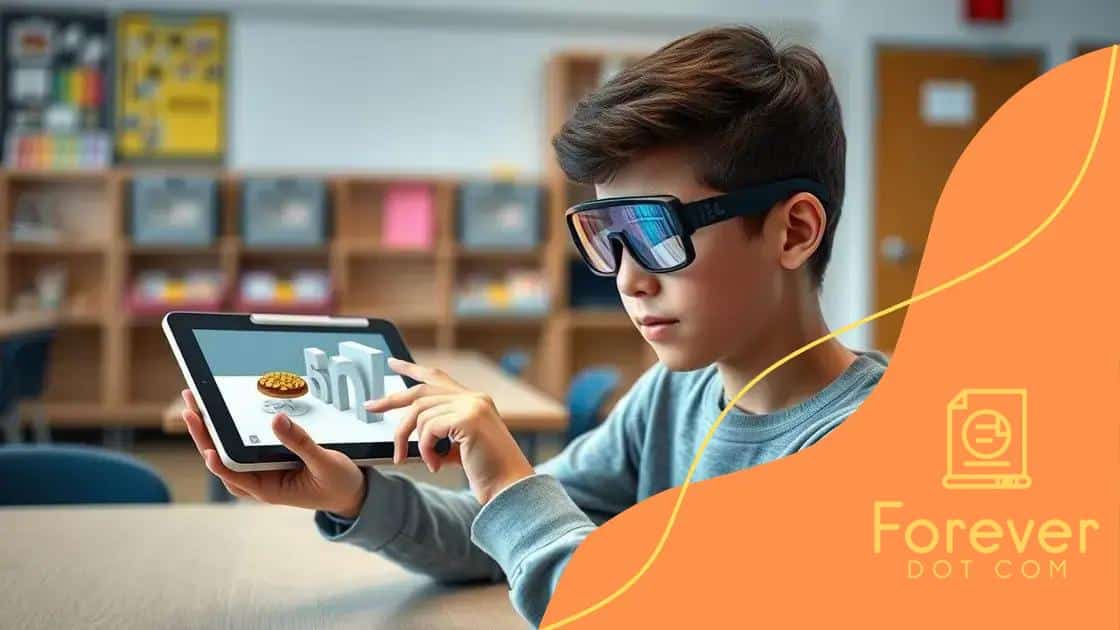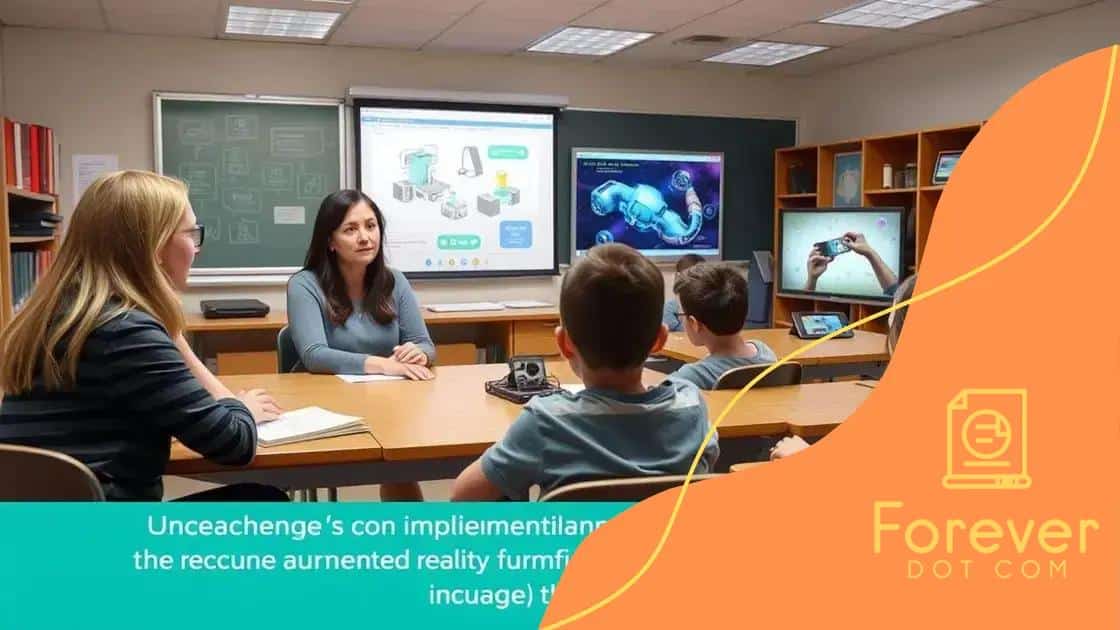The impact of augmented reality on higher education

The impact of augmented reality on higher education enhances student engagement, personalizes learning experiences, and fosters collaboration, making education more interactive and accessible for diverse learners.
The impact of augmented reality on higher education is shaping how students experience learning. Imagine being able to explore ancient civilizations or complex biological systems through immersive technology. This article dives into how AR is revolutionizing the classroom.
Understanding augmented reality in education
Understanding augmented reality in education is essential for grasping its transformative potential. This technology allows students to interact with digital content in a tangible way, enhancing their learning experiences.
What is augmented reality?
Augmented reality (AR) combines live views of the world with digital information. For example, AR applications can overlay images, videos, and sounds onto the real world through devices like smartphones, tablets, or AR glasses.
This immersive experience can make learning more engaging and interactive. Students can visualize complex concepts, explore virtual environments, and interact with content that was previously static and unexciting.
Benefits of augmented reality in education
- Enhances understanding of complex subjects
- Promotes active engagement with learning materials
- Facilitates collaboration among students
- Encourages exploration and experimentation
By bringing subject matter to life, AR helps students better retain information and develop critical thinking skills. Imagine a biology class where students can dissect a virtual frog or a history lesson that allows them to walk through ancient ruins.
Furthermore, AR can cater to different learning styles. Visual learners benefit greatly from the interactive content, while kinesthetic learners can engage with the material hands-on. This adaptability makes AR a powerful tool in today’s diverse classrooms.
Challenges in implementing augmented reality
Despite its potential, integrating augmented reality into education comes with challenges. Schools may face financial constraints, as acquiring the necessary technology and resources can be costly. Moreover, teachers need adequate training to incorporate AR into their teaching practices effectively.
Another concern is ensuring that the technology is accessible to all students, regardless of their backgrounds. Ensuring equitable access is vital for maximizing the benefits of AR in education.
In summary, understanding augmented reality in education provides insight into its numerous benefits and challenges. As technology continues to advance, exploring innovative ways to integrate AR can enrich educational experiences and prepare students for the future.
Benefits of augmented reality for students
The benefits of augmented reality for students are extensive and transformative. This technology enhances the learning experience by making it more engaging and interactive. Imagine being able to see a model of the solar system floating in your classroom!
Increased Engagement
One of the primary advantages of AR is that it boosts student engagement. When learners are actively involved, they retain information better. With AR, students can participate in lessons where they can touch, manipulate, and explore educational content.
- Visualizes abstract concepts
- Encourages active participation
- Makes learning fun and exciting
This interactive approach to education helps students feel more connected to the material. They don’t just memorize facts; they experience them, leading to deeper understanding.
Personalized Learning
Augmented reality also allows for personalized learning experiences. Every student has unique learning preferences and speeds. With AR, teachers can tailor lessons to meet individual needs.
By providing different layers of information, AR can support various learning styles. Visual learners can explore 3D models, while auditory learners benefit from accompanying sounds and narratives.
Collaboration Opportunities
AR creates opportunities for collaboration among students. Learners can work together on projects in ways that traditional methods do not allow. For instance, they can collaborate in a virtual environment, sharing insights and ideas in real time.
This teamwork not only encourages social skills but also helps students learn from one another. When they discuss and solve problems together, they engage more fully.
In addition, AR enhances critical thinking and creativity. As students explore and manipulate digital information, they develop valuable skills. They learn to analyze, create, and apply knowledge in dynamic ways.
Ultimately, the benefits of augmented reality for students are vast. From increased engagement and personalized experiences to enhanced collaboration, AR is reshaping how education happens. It not only prepares students for academic success but also for future careers in a technology-driven world.
Challenges in implementing augmented reality

Implementing augmented reality in education comes with various challenges that educators and institutions must consider. Despite its many benefits, there are hurdles that can inhibit successful integration.
Financial Constraints
One primary challenge is the financial cost associated with AR technology. Schools need to invest in various resources, including:
- AR hardware such as tablets or smartphones
- Software licenses for AR applications
- Training for teachers to use AR effectively
Many institutions operate with tight budgets, meaning that finding funds for AR can be difficult. Without proper funding, even well-meaning initiatives can stall.
Teacher Training
Teacher training is another significant obstacle. While AR technology can enhance learning, teachers need to be comfortable and skilled in using it. Proper training ensures educators can integrate AR into their lessons effectively.
This training must address not only how to use the technology but also how to design lessons that incorporate AR meaningfully. If teachers lack the necessary skills, the full potential of AR may go unrealized.
Accessibility Issues
Accessibility is a crucial consideration when implementing augmented reality in education. It is important to ensure that all students can benefit from AR technology. Socioeconomic factors can create disparities in access, as not all students may have the same access to devices or reliable internet connectivity.
Furthermore, content must be inclusive and cater to diverse learning needs. Developers must consider how AR can be utilized for students with disabilities and ensure that the experience is equitable.
Another challenge is technological integration. Schools may face difficulties in connecting AR technology with existing infrastructure. Issues such as incompatible systems or insufficient bandwidth can hinder the AR experience.
In addition, resistance to change can occur among educators and administrators who may be hesitant to adopt new teaching methods and technologies. Overcoming this skepticism is vital for creating a supportive environment for integrating AR.
Ultimately, while integrating augmented reality into education offers incredible potential, addressing these challenges is essential for successful adoption. Schools must approach these obstacles systematically to ensure that AR technology can enhance learning and academic performance.
Case studies of augmented reality applications
Case studies of augmented reality applications in education reveal how this technology is changing classrooms around the world. These real-life examples highlight the practical benefits and innovative uses of AR in different learning environments.
Medical Training
One significant case study involves medical training programs that integrate AR to enhance learning. Medical students can interact with 3D models of human anatomy. This technology allows them to visualize complex structures and gain a better understanding of how the body works.
For instance, the Harvard Medical School has adopted AR to allow students to experience surgical procedures in a virtual space. This hands-on experience prepares them for real-life surgeries, making them more confident and skilled.
History Education
Another captivating example comes from history education. The National Museum of Natural History in Washington, D.C., uses AR technology to bring exhibits to life. Visitors can use their smartphones to scan displays and access 3D models of artifacts, providing deeper insights and engaging experiences.
This interactive approach makes history more relatable. Students can explore ancient cultures like never before and understand their significance in modern society.
Language Learning
In language learning, AR applications have gained popularity as well. Programs like Duolingo are experimenting with AR features that allow students to practice vocabulary in real-world contexts. By using their device cameras, learners can point at objects around them and see translations pop up on their screens.
This situational learning enhances retention and helps students connect vocabulary with real-world scenarios. Such applications make learning a new language engaging and practical.
STEM Education
AR is also making waves in STEM (Science, Technology, Engineering, and Mathematics) education. Schools are using AR apps to create interactive, hands-on lessons in subjects like physics and chemistry. For instance, apps can simulate chemical reactions or physical forces, allowing students to visualize concepts.
Moreover, AR can facilitate experiments and encourage exploration, driving curiosity in young learners. When they see science in action, they are more likely to get excited about the subject matter.
These case studies of augmented reality applications demonstrate the potential for innovation in education. By showcasing effective implementations, other institutions can learn how to adopt AR, creating enriching learning experiences for their students.
Future trends in augmented reality for higher education
The future trends in augmented reality for higher education point to a more immersive and interactive learning experience. As technology advances, both educators and students are excited about how AR can reshape classrooms.
Increased Accessibility
One trend is the growing accessibility of AR tools. As more affordable devices and applications become available, more schools can adopt this technology. Enhanced accessibility means that students from various backgrounds can benefit from augmented reality experiences.
For instance, cheaper AR headsets and applications can provide quality educational content without burdensome costs. Schools with limited budgets can integrate AR to enhance engagement and understanding.
Integration with Artificial Intelligence
Another emerging trend is the integration of AR with artificial intelligence (AI). Combining these technologies can create highly personalized learning experiences. AI can analyze students’ progress and tailor AR content to their needs.
This means that students can explore subjects at their own pace, receiving feedback and assistance tailored specifically to their learning style. These adaptive learning environments will enhance student success.
Collaboration through AR Platforms
Future AR platforms will likely focus on collaboration. Students will be able to work together, no matter where they are, through shared AR experiences. Imagine students in different parts of the world collaborating on a science experiment or attending a virtual lecture together.
This collaboration can foster communication skills and cultural exchange among students, enriching their overall educational experience.
Developing STEM Skills
Further, there is a significant push toward using AR in STEM (Science, Technology, Engineering, and Mathematics) education. As schools integrate AR into their curricula, students will engage in hands-on learning that promotes critical thinking and problem-solving skills.
Within AR environments, students can visualize complex scientific concepts or simulate engineering projects. Engaging in these interactive experiences prepares students for future careers in high-demand fields.
Finally, the expansion of augmented reality in higher education holds exciting potential. By breaking down barriers to learning and fostering collaboration, AR is set to revolutionize how students engage with information. The focus on personalized, accessible education will ultimately lead to a more deeply engaged student body, ready to tackle future challenges.
In summary, augmented reality has the potential to revolutionize higher education by making learning more engaging and accessible. As technology evolves, we can expect exciting advancements that will enhance how students interact with their education. By combining AR with tools like artificial intelligence, educators can create personalized experiences that meet the diverse needs of learners. Moreover, the growing focus on collaboration and STEM skills will prepare students for successful futures. Embracing these changes can lead to a more dynamic and effective educational environment.
FAQ – Frequently Asked Questions about Augmented Reality in Higher Education
How does augmented reality improve student engagement?
Augmented reality makes learning more interactive and fun, allowing students to visualize concepts and participate actively in lessons.
What are the challenges of implementing AR in schools?
Challenges include financial constraints, the need for teacher training, ensuring accessibility for all students, and overcoming resistance to new technologies.
Can augmented reality support personalized learning?
Yes, AR can adapt to each student’s needs, providing customized content and feedback to enhance their learning experience.
What future trends can we expect in AR for education?
Future trends include increased access to AR tools, integration with artificial intelligence, and enhanced collaborative platforms for students.






